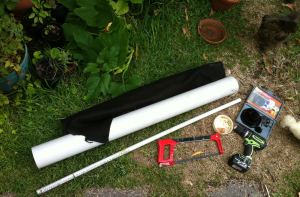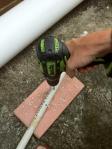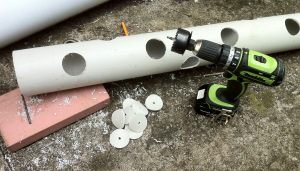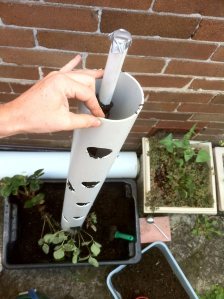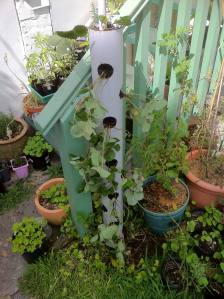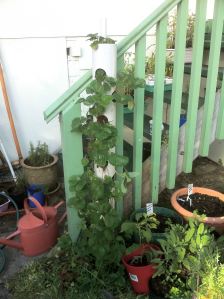How to make a vertical strawberry tube planter
Seeing as this is around the time you should be planting your strawbs I thought it timely to write about this vertical strawberry planter I made a few months back. Instead of writing about it straight away I thought it would be better to test it first so have waited until it was established, yielding fruit and can advise on where I would do things differently.
After I built this, I found a version for sale at a major garden retailer so you can just go and buy one if you can’t be bothered making it but they’re pretty easy to make.
You will need:
- An electric drill with a hole cutting bit that will cut a 5 – 7cm hole
- A 2 or 3mm drillbit for the watering pipe
- A length of PVC downpipe 100mm or 150mm diameter. (The length will = the height of the unit)
- End cap for the downpipe
- A narrower diameter (15mm or thereabouts) length of downpipe for watering. Make it about 8 – 10cm longer than the downpipe. If you have a pressurised irrigation system, you can use a length of soak hose instead
- A cork
- A knife
- Duct tape
- A length of geotextile (or hessian would do) for wrapping the watering pipe
- Twine for tying the fabric to the watering tube
- Good fertile soil (test it if you can – strawbs prefer it slightly acidic)
- 1 litre or so of coarse gravel
- Strawberry plants (I used a mixture of different varieties)
- A few companion plants (nasturtiums or marigolds)
- Large tub or box (to stand unit in whilst filling)
- Fixing collar or ties
Step 1: Cutting
Decide on length of unit and cut the tower tube and watering tube accordingly. Don’t forget to make the watering tube 8-10cm longer! I made mine the height of the outside staircase outside as it gets pretty good sun there and the rails give me something to secure the unit to.
Step 2: Drilling the watering tube
Drill vent holes in watering tube. Only drill these in the top 2/3 of the tube as the water will run down to the bottom plants. If you put holes all the way down the upper planter won’t get quite enough water as it will all rush out the lower holes. If you think you will do a good job of capping off the base end of the tube, you can put one small hole at the bottom so it doesn’t go anaerobic in there.
Step 3: Completing the watering tube
Cut the geotextile or hessian to the shape that will cover the holes in the watering pipe. You don’t want roots getting in there and clogging it up.
Then carefully with a knife, whittle down the cork til it fits the end of the watering tube. Now seal it off with duct tape (You don’t want this coming apart whilst you assemble/plant the unit!)
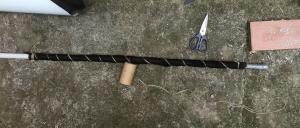
The completed watering tube prior to insertion into the strawberry tower. Cork has been attached and twine holding geotex in place.
Step 4: Cutting the holes in the tower
Cut the holes in the tower tube. Remember that one side will face the wall so only put holes on the surfaces that will get sunlight. I made 3 rows of holes and staggered them with holes about 20cm depth apart vertically. Leave the last 20cm intact with no holes. Some of this will be a reservoir of the lower level plants.
Step 5: Filling
Place the large container against the wall – a corner is best so the tube is less likely to fall over. Place end cap over the base of the tube (I didn’t seal mine so I can dissemble the unit and make modifications if necessary.) Insert watering tube then fill the bottom 10 cm with coarse gravel.
Step 6: Planting: For the lowest hole I recommend planting a companion, less incentive for pests to climb up. If you are using stoloniferous varieties (those strawberries that spread with runners along the surface) you can leave a few gaps in the lower holes. As the runners cascade down you can poke them into these vacant spaces. Saves a few bucks, huh? When filling, I found it easiest to pour the soil from the top and poke the plants in the holes. Make every 6th one a companion.
Step 7: Location:
Once it’s planted find make sure when moving it that you hold it with one hand under the endcap if it’s not fixed. (Nothing like watching your plantings all shoot out the end to remind you of this necessity.) Secure it with your chosen fixings.
Watering: You will need to do this daily in warmer weather. Vertical units do require vigilant watering. The last thing you want is for it to dry out!
Handy tip. If you are noticing ants farming aphids on your strawberries, locate their path then smear some orange/citrus oil around the unit at this point. Stops them in their tacks!

